Giant (1956)
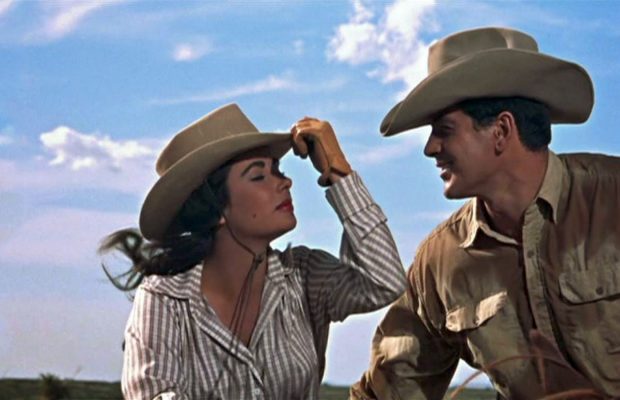
Toronto Film Society presented Giant (1956) on Monday, December 20, 1982 as part of the Season 35 Monday Evening Film Buffs Series “B”, Programme 4.
Production Company: Warner Brothers. Producers: George Stevens, Henry Ginsberg. Director: George Stevens. Screenplay: Fred Guiol, Ivan Moffat, based on the novel by Edna Ferber. Photography: William C. Mellor. Music, Composed and directed by: Dimitri Tiomkin. Editor: William Hornbeck. Film Editor: Fred Bohanan, Phil Anderson. Filmed in Virginia and Marfa, Texas.
Cast: Elizabeth Taylor (Leslie Lynnton Benedict), Rock Hudson (Bick Benedict), James Dean (Jett Rink), Mercedes McCambridge (Luz Benedict), Chill Wills (Uncle Bawley), Jane Withers (Vashti Snythe), Robert Nichols (Pinky Snythe), Dennis Hopper (Jordan Benedict III), Elsa Cardenas (Juana), Fran Bennett (Judy Benedict), Carroll Baker (Luz Benedict II), Earl Holliman (Bob Dace), Paul Fix (Dr. Horace Lynnton), Judith Evelyn (Mrs. Horace Lynnton), Carolyn Craig (Lacey Lynnton), Rodney Taylor (Sir David Karfrey), Alexander Scourby (Old Polo), Sal Mineo (Angel Obregon II), Monte Hale (Bale Clinch), Mary Ann Edwards (Adarene Clinch), Napoleon Whiting (Swazey), Charles Watts (Whiteside), Maurice Jara (Dr. Guerra), Victor Millan (Angel Obregon I), Pilar Del Rey (Mrs. Obregon), Felipe Turich (Gomez), Sheb Wooley (Gabe Target), Francisco Villalobos (Mexican Priest), Ray Whitely (Watts), Tina Menard (Lupe), Ana Maria Majalca (Petra), Mickey Simpson (Sarge), Noreen Nash (Lona Lane), Guy Teague (Harper), Natividad Vacio (Eusubio), Max Terhune (Dr. Walker), Ray Bennett (Dr. Borneholm), Barbara Barrie (Mary Lou Decker), George Dunne (Vern Decker), Slim Talbot (Clay Hodgins), Tex Driscoll (Clay Hodgins, Sr.), Juney Ellis (Essie Lou Hodgins).
Giant opened at the Roxy, New York, October 11, 1956.
MEMBERS PLEASE NOTE: The film’s running time is approximately
three and a half hours and there will be NO INTERMISSION, even though
the print may indicate an Intermission. People will be advised
to “snack up” before the movie begins.
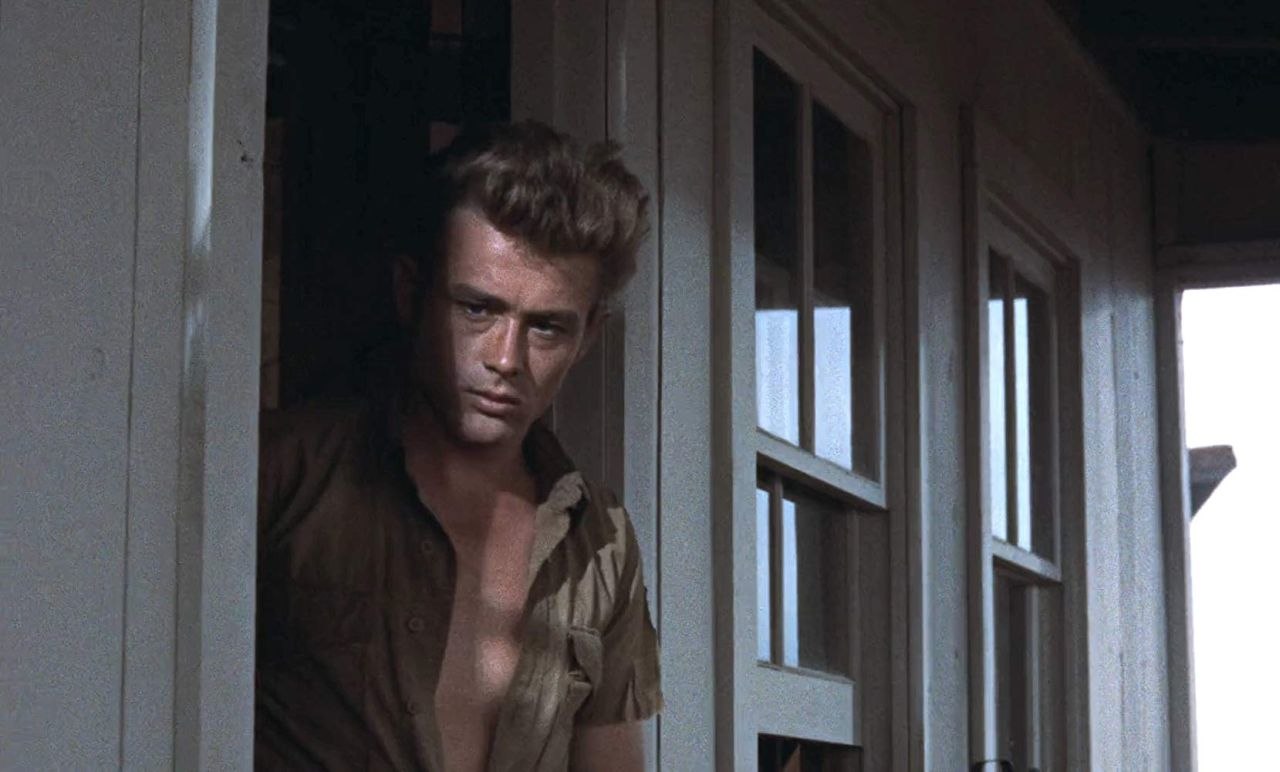
Two years were spent transcribing Edna Ferber’s novel “Giant” for the screen. Detailing the history of a Texas “royal family”, the novel is massive and sprawling–a big, but not great, American family saga. Some critics felt the same way about the film, yet the director, George Stevens, captures quite well the visual sweep of an epic, the saga of a society on the move from the cattle conscious twenties to the oil-drenched fifties. Intimate moods are also well created, eg. the quiet scenes of the married couple together. Stevens had total control of the film and was willing to show how far he would go to avoid stereotypes by casting actors who had never before appeared in westerns. He is a director well known for painstaking details and extravagant shooting methods (not to mention the long gestation periods spent creating his later movies such as A Place in the Sun, Giant, The Diary of Anne Frank and The Greatest Story Ever Told). Stevens constructs his movies by shooting each scene from every possible angle, then masterfully editing the best shots out of miles of film–a technique which apparently drove James Dean stir-crazy. He referred to it as “Stevens’ around the clock method”.
Ferber’s novel never sat well with Texans with its implicit criticism of their ostentation, snobbery, and excesses, and Stevens is faithful to the text. However, even he has trouble with the contrived romance between the son and the Mexican girl. The sentiments are irreproachable but the exposition is naive. The unpolished neighbours (a marvellously raucous Jane Withers ) are perfect.
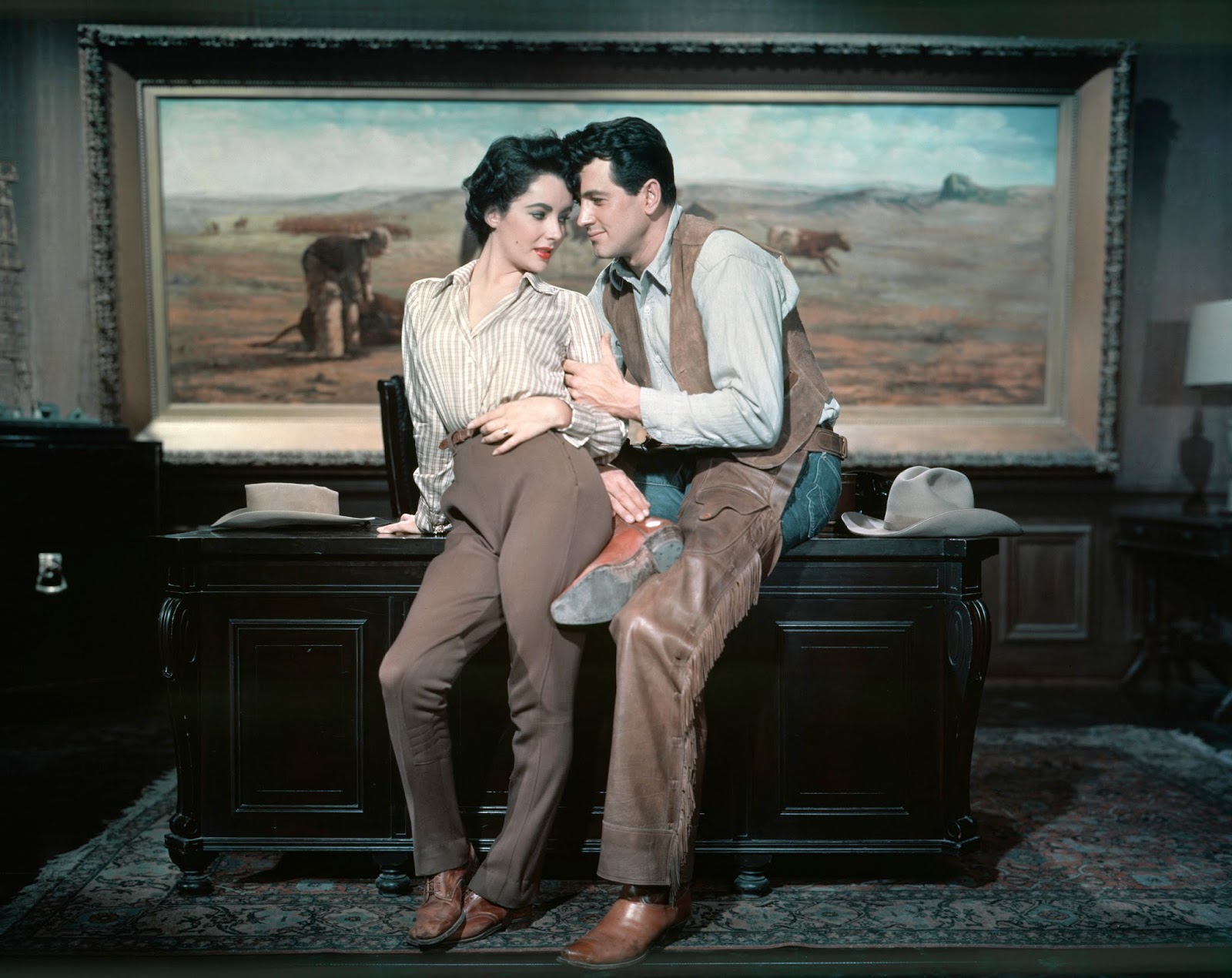
Apparently location shooting was a horror for the entire crew with the exception of Elizabeth Taylor and Rock Hudson, who had their own houses. Everyone else was “corralled” in an old hotel. In her book “The Quality of Mercy’ Mercedes McCabridge made the following obervations: “Giant was filmed, in large part, in a large part of a large place called Texas”…”in a large part of the ugliest landscape on the face of the earth”…”No hills, no water, no trees, no grass, just vast acres of creepy-crawlies and dive-bombing bugs and biddy towns thousands of miles apart. One such town is Marfa, Texas. Marfa! Even the name evokes magic! It is located somewhere south and east of El Paso in a region of the damned”…”There was a hotel where our company was quartered”…”The kitchen gave off a scent of frying fat, twenty-four hours a day. Everything edible is fried in Texas! Or it is buried in the ground to cook before it is eaten”…”The steaks at night are big and bright deep in the heart of Texas. And they are always afloat in grease. Next morning you are served a smaller steak, which serves as a platform for two fried eggs”…”all of this afloat in the same grease.”…”Nieman Marcus is one thing, and the Dallas Cowboys are another, but Texas food should be forbidden!”
Stevens’ first choice for the female lead was Grace Kelly ,and apparently Alan Ladd was considered for the role which went to James Dean. Dean badly wanted the part and went after it with a vengeance. He greatly admired Stevens, although his admiration was sorely tested during the actual filming. Elia Kazan, who directed Dean in East of Eden, is actually more his kind of director and Penelope Houston, in a review of the film in Sight and Sound, Winter 1956-57, observes: “Dramatically, the story loses through the failure to bring Jett Rink sufficiently close to the centre of action. At the outset, Rink is sullen, wary, restless. The script presents the character through a series of statements, but James Dean’s performance is a matter of implications, suggestions of neurotic stresses and tensions. The delicate little scene in which he entertains Leslie Benedict (Taylor) to tea, the shots of the ranch-hand pacing out the boundaries of his property, glorifying in the fact of ownership, are beautifully managed. In the later scenes, though, Dean for the first time in his tragically short career had to go beyond the characterization of the young rebel; and his technical resources fail to see him through. His relative failure (and it is only relative) throws some incidental light on Stevens’ direction of his players.”…”Putting it very approximately, one might say that Kazan works through his actors, while Stevens prefers his actors to work through him–the value of the performance, in other words, is essentially its contribution to the mood and temper of the individual scene. A somewhat limited player, such as Elizabeth Taylor, can appear at her best in a Stevens picture; an actor like James Dean seems to putting more into the part than the director needs for his own purposes.”
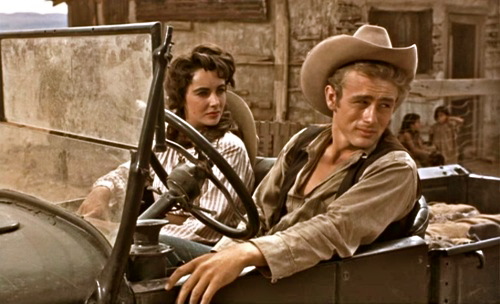
In Film Culture, Vol. 4, 1956, Andrew Sarris had this to say: “Unlike Kazan, Stevens does not manipulate his players into one style of acting. He obtains conventional extroverted performances from Rock Hudson and Elizabeth Taylor, a compressed explosive radio delivery of lines from Mercedes McCambridge, and a pair of actor’s studio interpretations from James Dean and Carroll Baker.” Rock Hudson is certainly appropriately cast for he has the size and authority to embody the bigness of Texas or, as one critic put it, he is solid as Gibraltar, throughout, and half as expressive. Hudson’s and Dean’s mutual contempt for each other probably served them well for their on-screen hostility. Like Dean, Hudson’s “aging” is not very convincing. (There is, in fact, a problem with the passing of time, from 1923 to the 1950s as there is no indication of just what historical moment we are passing through, except for a couple listening to news of Pearl Harbor on a car radio. This may, however, be an indication of the character of the Lone Star state.)
Only Elizabeth Taylor manages best with the aging process, growing old with grace. Stevens draws out her most appealing features, her delicate beauty as a young bride, her cool limpid playing full of colouring and emotion and, as she matures, as woman of spirit and sensitivity, both engaging and beautiful. A strong heroine, in her struggle to retain her liberal attitudes and assert her rights of feminism she is an interesting illustration of the modern woman.
The film’s temp is slow and controlled, which places a lot of weight on the script. Perhaps the film’s, and the novel’s, weakness is the weakness of the big, as opposed to the great. However, Stevens keeps a steady grip on his subject and by sheer weight an scope, Giant succeeds in being entertaining for most of its three and a half hours–a not inconsiderable achievement. Stevens won an Academy Award for his direction of Giant although the award for Best Picture that year went to Around The World In 80 Days.
Notes by Barry Chapman


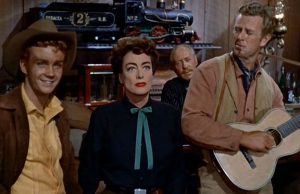
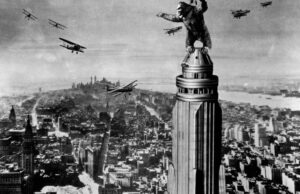






Leave a Reply